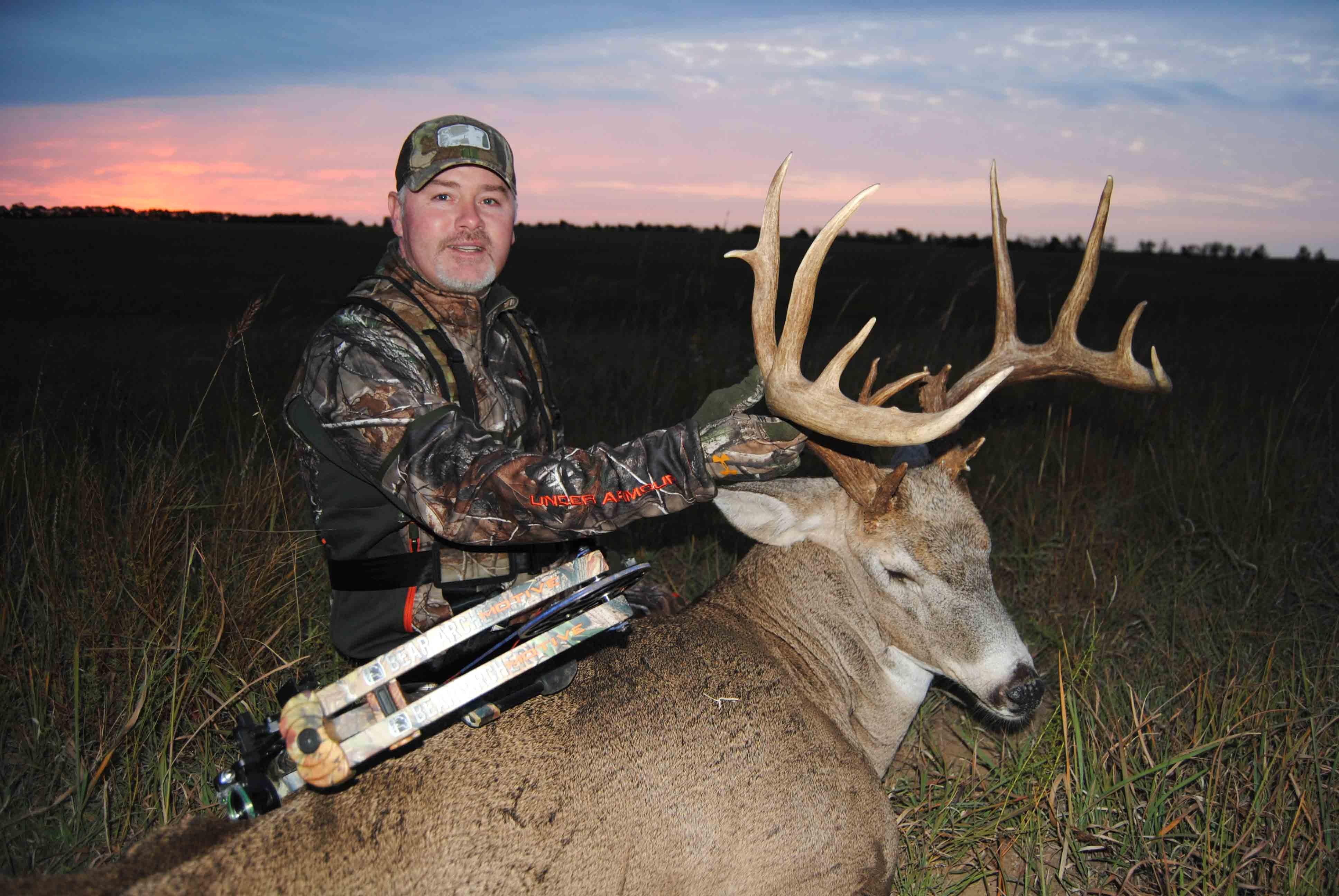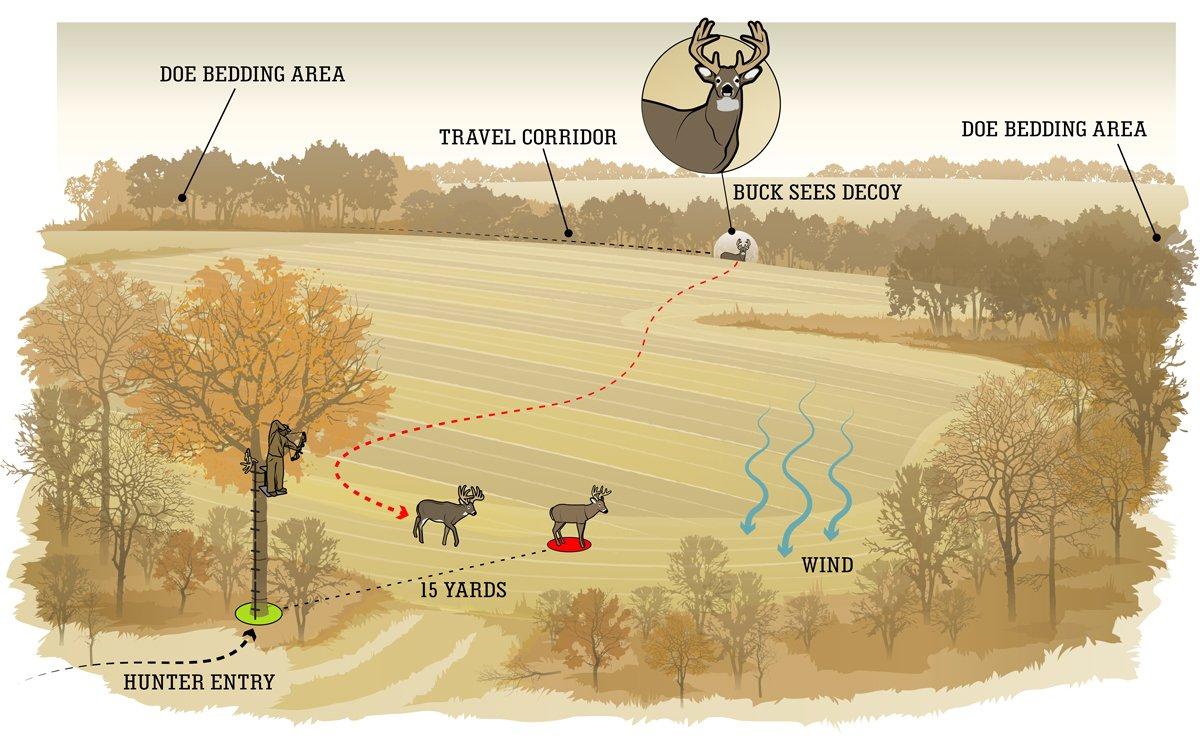How to Decoy a Buck
A battle-scarred buck walks into an open field and spots your decoy. His ears lay flat against his head, and the hair on his neck bristles. With stiff legs and rigid back, he slowly closes the distance to chip-shot bow range, ready to trash that fake intruder. Not all deer hunting is passive. This is, as they say, making it happen. And if you do your part, it's a common experience when you're hunting over a decoy.
Jeff Danker, Realtree pro-staffer and host of Major League Bowhunter, spends a good portion of his season hunting open-country bucks in Oklahoma and Kansas. He's learned to use decoys and calling to his advantage by necessity. Seeing a big deer in that country is pretty easy. Getting it into bow range? Not always. But the decoy helps. Here's how Jeff does it.
Tools of the Trade
- Standing buck decoy
- Stakes
- Rubber gloves
- Scent-eliminating spray
- Patience
When to Decoy
First Window: Halloween - November 10th
Second Window: November 24th - December 5th
Mornings have produced the best results for Danker during these windows.
There are two periods when decoying is most effective. The first is just before the bulk of the does start coming into estrus. The second is approximately 28 days later. This is the time during the late season when doe fawns become receptive and un-bred mature does cycle again, Danker said.
This timeframe obviously varies slightly each year. Weather, temperature, pressure, the moon and countless other factors play a role in when the magic happens. So it's important to watch deer behavior when deciding whether or not to deploy the deke. If you see deer chasing and cruising for does, the time is right.
Decoys can work for sure. But they can also spook deer when used incorrectly. Before learning how to use a decoy, you need to learn how not to use.
- Don't use decoys in feeding fields during the afternoon. You'll spook does coming in to feed.
- Don't lay the decoy, bow and backpack down in the grass while you tie your boots. You'll contaminate the whole system with scent.
- Don't handle your decoy with bare hands.
- Don't set a decoy in thick areas. The farther they can be seen, the better.
- Don't put your decoy more than 10 to 15 yards from your tree.
- Don't use a decoy unless the rut is kicking. Using a decoy early or late will only educate deer.
- Don't take any shortcuts. Do everything right, or expect to fail.
Don't Miss: 7 Reasons You Can't Decoy Deer
Map It Out
It's vital to have a game plan. You can't just wake up one morning and decide you're going to toss a decoy out for the heck of it.
- Think ahead. If you're hunting one evening and see bucks chasing does, go ahead and plan for a decoying attempt the next morning.
- Plan an entry route that has quiet access that will not bump deer.
- Allot plenty of time to slowly walk in. You don't want to work up a sweat.
- Upon arrival, make sure you set the decoy up properly and remember all factors.
- Use a grunt call to add realism.
Decoy Positioning
The direction you face the decoy is crucial for success. You can't just drive stakes in the ground and point it in any direction. Care has to be taken. For a long time (and still today), people urged others to point the buck quartering slightly toward the hunter. Their belief was that the buck often comes into the decoy head-on. However, my experiences have not produced these results. Often, my experiences have found bucks to visit the tail end before circling to confront the decoy face-to-face afterward, Danker said.
The lesson? Quarter the decoy slightly away.
Avoid the Does
It's important to implement decoys where up-close doe sightings will be minimal. More times than not, does will stomp, blow, kick and cuss when a decoy remains still for too long. So try to avoid the ladies on this hunt.
A good area to look for is an open field between two doe bedding areas. During the rut, bucks will cruise from doe bedding area to doe bedding area in search of a hot doe. Setting up a decoy in an area like this will catch that big deer off guard and fire him up, Danker said.
Stay Scent-Free
Wearing rubber gloves when handling a decoy is of paramount importance if you want to draw ol' Sad Daddy into range. After placing the decoy, don't forget to spray it decoy down from head-to-tail with a scent-eliminating product.
Deer can decipher 28 different smells in one sniff. I always spray my decoys down thoroughly with EliminX to kill human odor and other undesired scents. It is OK to use dominant buck scent or doe urine with decoys. But I choose not to. I do not like any scent around my decoy, Danker said.
Danker has been known to run a decoy through a car wash (more than once) to help reduce scent.
Don't Miss: How to Use a Deer Decoy
Decoy Combos
Other decoy combinations such as a single standing doe, a standing buck with a standing doe, and a standing buck with a bedded doe will all produce results. But most hunters get the best result from using a single posturing buck decoy that has pinned ears, rigid back and stiff legs. A doe decoy will often attract other does, and if you're not planning to shoot a doe, they'll figure the game out and bust the setup.
Patience Pays
You won't be successfully without patience. By decoying, you are targeting frustrated bucks that are ready to fight. So odds are you will see some action. But sometimes it doesn't come together. You will learn from experience when and when not to implement a decoy. I've seen deer and then pushed them out of the area due to using a decoy at the wrong time. Decoys aren't magic, but they can be magical. But only if they are used correctly, Danker said.
Don't Miss: How to Hunt the Phases of the Rut
Editor's Note: This was originally published October 22, 2013.
Are you a deer hunter wanting to learn how to accomplish your goals? Check out our stories, videos and hard-hitting how-to's on deer hunting.







